In an ideal world, your leads will maneuver themselves down the marketing funnel. But that’s not how things work. Lead nurturing is essential to urge your leads to move down the marketing funnel- from visitors to leads, buyers, and lastly, promoters. It’s not a one-day wonder. Rather, lead nurturing is a long process. According to Forrester Research, companies that implement lead nurturing practices have about 50% more conversions.
Another study from eCommerce reveals that nurtured leads are 47% larger as compared to leads that are not nurtured. Despite the numbers, research shows that only 36% of organizations and brands have adopted lead nurturing practices (Which is actually low).
What is Lead Nurturing?
Lead nurturing is an integral part of inbound marketing. By definition, lead nurturing refers to the various marketing efforts of a marketer to successfully convert a lead to become a buyer and then promoter. It is not forced marketing. Rather, lead nurturing efforts involves relevant content and based on lead behavior or needs.
In other words, you can call lead nurturing as a relationship building process- where a brand tries to get the attention of their target buyers and build a personal relationship with them. You, as a brand or product, listen to their demands, complaints, and needs. In return, you provide the information and answers that they need.
Through this communication of educating and creating perception, your qualified leads slowly become your customers.
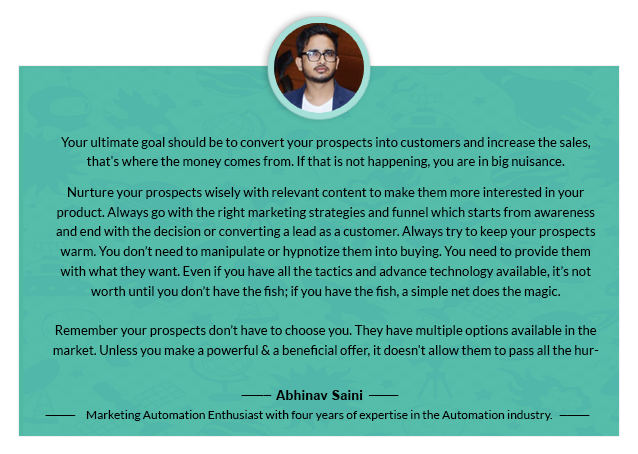
Why do you need Lead Nurturing?
Lead nurturing is the process of interacting with potential customers in a more personalized manner, at different stages of their lifecycle. Lead nurturing differs from lead management, as it focuses on active contact with valuable leads, engaging them, and produce an ongoing dialogue or communicate in terms of nurturing efforts to build trust and a relationship.
Implementing powerful lead nurturing plan to amp up your prospects’ engagement is essential for marketing and sales teams and one of the best way to excel at their job. It is also essential for companies that do not nurture their leads because it will actually help communicate better and ultimately improve unique sales process and produce a powerful backbone for business. With lead nurturing, non nurtured leads or opportunities can be captured and nurtured until they are ready to buy something from your company as per their needs.
According to recent research, about 96% leads that visit your website are not yet ready to buy. It is on you to push these leads through the funnel by educating them.
Lead nurturing process can be broadly divided into three basic stages: Awareness, Consideration, and Decision. Only when a lead reaches the ‘Decision’ stage, you can start pitching your products and services directly. Prior to that, all you do is build a relationship.
Does Lead Nurturing end with ‘Decision’ stage?
NO. There is no ‘end’ to lead nurturing. Let me give you an example.
Sometime back, I traveled to Europe with Emirates. Now talking in marketing terms, I have purchased a flight from Emirates, indicating that I have come over the ‘decision’ phase and am now a customer. Ideally, I have reached the end of the marketing funnel of Emirates. Hence, there’s no more nurturing required for a lead like me, isn’t it?
WRONG.
After I made a purchase, it was evident I have invested my trust in this brand. I have picked this brand out of many other options who were offering me flights on the same route. And Emirates as a brand now knows that.
If a brand leaves a lead like me on my own, chances are that I will forget this brand in the long run. It’s not same as I am traveling to Europe every day! Let’s say Emirates stop connecting with me henceforth. On the other hand, other brands who still consider me as a prospective lead after I browsed their websites will keep connecting back. Chances are high that when I will need to book another flight, I might just not opt for Emirates again. Because all these while, other flight operators reached out to me with best deals.
Still Not an User of Aritic PinPoint Automation?
And that’s exactly why lead nurturing never ends even if your lead has reached the ‘buying’ stage. Here’s an email I received from Emirates recently (out of many others)-

To cut the long thing short, Lead Nurturing is like a cycle-it starts from the time a visitor arrives on your website and continues as long as the association continues.
So, how does a brand nurture their leads effectively?
Let’s look at the above example from Emirates again. It has a tagline “Let the celebrations begin”. If you look closely at the image- It is personalized. How? Look at the Tri-colour dress code of the girl in the image. This email is designed for a customer like me, residing in India and is scheduled just prior to Independence Day. Emirates is a global company with customers spread across so many continents.
So, this one is not for all the customers. It is only for those residing in India or frequent travelers to India. You see, it is a common human psychology to get all perked up when an occasion is around the corner. Most people opt to travel during these holidays!
This brings us to the conclusion that this email is well planned, designed and targeted. The immediate question is how?
And the most obvious answer is: Marketing Automation.
Marketing automation is a solution that helps in automating certain repetitive marketing tasks like emails, website actions, social media, etc. Without marketing automation, it is not possible to nurture leads effectively. To nurture a lead properly, you will need information about that lead. This is followed by segmentation, email campaigns, education content, social media interactions, etc. Before you start nurturing your leads, it is crucial to build your buyer’s persona.
Buyer’s persona is a semi-fictional representation of your leads after they have signed up or subscribed to your platform. You use a marketing automation tool to put together all the information of that lead in one place and segment it based on demographics, browsing behavior, job title, etc. By creating a buyer’s persona, you can understand what kind of solutions or services that lead will benefit from. Depending on their browsing pattern, you can assume their problem statement, followed by which you can send resources.
Lead nurturing requires a detailed understanding of your leads. And marketing automation is the key to it. Here are 9 effective ways in which marketing automation aids lead nurturing.
Related Post: 7 Actionable Strategies to Win More Customers
9 Effective Ways to Improve Lead Nurturing with Automation
If you want to improve lead nurturing, then advanced automation is a great way to do so. It will help you automate the process of sending out direct mail messages and nurture your leads in real time. There are certain ways that can be done with automation. The most prominent thing to remember is that automation should be used in conjunction with traditional marketing methods. It will still help you increase sales and improve your conversion rate.
All lead nurturing activities begin with proper segmentation. So, the first way to improve lead nurturing is by improving email list segmentation. And that will be our first point of concern on this list.
I. Advanced Contact List Segmentation
When you segment your leads properly, it becomes easy to build and send relevant emails to each list. You cannot expect a 60-year old entrepreneur taking interest in stuffed toys unless he/she has a kid and previously he/she did browse in that category. It is very complicated to do it manually. That’s why trusting a strong automation tool to bucket all your leads is a good idea. Since marketing is all about personalization and relationship building, segmentation can happen on the basis of:
- Demographics like age, gender, location, country, religion, etc.
- Events, where a particular action triggers emails that are pre-planned.
- Buyer’s stage- based on the stage of your buyer, leads are segmented and email campaigns are redirected.
- Website behavior of your leads on your website or app.
Now let’s take a deeper look into how automated segmentation improves lead nurturing.
Remember that email I shared from Emirates in the beginning? Yes, that tri-color dress code one. That is an example of an email targeted to Indian audience like me. This means, the moment I had signed up, I was segmented into a list based on my ‘country’ details.
Looking at my previous purchase history, they sent me an email containing details of flights routes that I might be interested in. You can say, a lead with details like me made way into two lists- one was based on my country, the other was my purchase history. That’s precisely how demographics contribute to targeted emails.
Now, take a look at this email from DropBox.

This is an email specifically designed for leads who signed up with Dropbox but never installed it. These leads have stopped right at the top of the marketing funnel. Also, you can call this email as a re-engagement email, sent to leads who haven’t engaged with Dropbox for a long time after signing up. That’s how the buyer’s stage is considered for better lead nurturing.
Next, we have lead behavior. Here, let’s take Amazon for example. A few days back I was looking at some headphones. Although I wasn’t very keen on buying one, I was casually browsing. And then I quit to move on with my other works. What follows next is an email from Amazon with a compilation of headphones that might interest me.

Since I spent considerable time on their website browsing headphones (particularly of the JBL brand), I received an email aligned to exactly what I was looking for. This email is based on my behavior on their website. Since I spent the majority time browsing a particular brand (here JBL), Amazon designed an email with the best offers from that brand only. This is another way of nurturing leads where you send emails on exactly what they were looking for and making the task easier for them to get going instead of quitting.
And yes, this is just the first email out of many more that Amazon sent me. Interestingly, their emails are not annoying or interruptive. Rather they are carefully designed, timed and aligned. That’s how automation is put to use to continue nurture leads. Talking about the buyer’s stage in which I was, in this case, I was in the decision phase- where I had decided my choice of brands and price range.
II. Email Marketing
Segmentation is followed by targeted and relevant emails. Email marketing is the core of lead nurturing. Email marketing is one of the most effective ways to nurture leads, but it requires a lot more work and dedication than other channels.
Lead nurturing: A process by which leads are nurtured through a series of communication with the aim of transforming them into loyal customers.
Email Marketing: The practice of sending commercial emails to a list of potential or existing customers using email marketing solution.
Since emails are touted as the most effective mode of communication for brands, it is but obvious enhancing email marketing automation will help in improving your lead nurturing and ultimately help build trust. There are several types of emails that marketers automate:
- Welcome email- when someone subscribes or signs up or joins a group/community.
- Thank you an email- when you have made a purchase or donated something or given feedback.
- Onboarding emails-where a brand sends a series of emails to help their new leads in getting started or a series of emails to educate leads more about the industry.
- Newsletters and updates
- Exclusive offers and discounts
- Re-engagement emails
- Cart abandonment emails (for eCommerce)
- Notification emails; etc.
Make sure to use autoresponders for situations like ‘new subscription’, ‘new comment’, etc. You can also plan relevant drip email campaigns created that trigger emails based on user behavior. Drip emails are mostly designed on the “if-then” condition. Like, if a user clicks on the in-mail link and visits your new page, then you will send more updates on how it will benefit him/her. Else, you send more educational content so that they visit that page next time.
Execute Effective Marketing Automation Workflows Now
Know more about Drip Email Campaigns: Multiply Your Customer Acquisition with Drip Campaigns
For instance, this email from Amazon-

I did browse the ‘business’ section once, but I did not spend a lot of time clicking the links and checking them. Amazon sent me this email where it has highlighted the core three benefits I will get if I create a business account for FREE. Yep! that free word has a lot of weight than said, it can also be presented by giving a free trial.
But that was not all in that email. It also had information of various products that I had recently browsed through their portal. So, while their main aim was to tell me about the benefits I might be missing out on, they also made sure I never forgot those items that took me to Amazon in the first place.
Brands use emails to stay connected with their users round the clock. If you are not connecting and nurturing, then your leads might forget you. Let’s take another quick example from Quora– the most popular question-answer platform. I had answered a few questions on email marketing lately, and some people did upvote my answer. Quora send you a notification via email when your answer receives an upvote. Something like this:
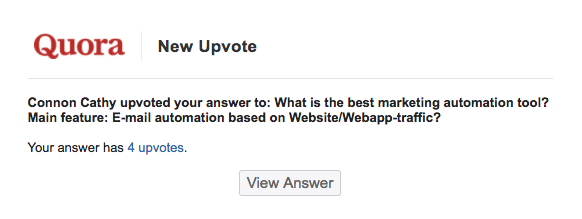
Here’s what an email like this will do to you-
You have written an answer to a question. Someone else found it useful and gave it an upvote. It is human psychology to feel good when your work gets appreciated or recognized or helps someone else. With an email like this, you will automatically click on the link and visit that answer again. Once you reach the platform, you see many other questions posted on a topic that you can contribute to. Since you have received an appreciation, you are most likely to answer another question.
And that’s how Quora ensures user engagement.
I’m not saying you’d do this every time, but once in a while, you will!
Related Post: Know How Emails Can Reduce Your Churn Rate
III. Lead Scores
Lead scores are scores that you assign to each lead depending upon their behavior and engagement with your emails, on your website and app. For each activity, you assign a score. The lead that has the highest score is the most potential lead. Nurturing this lead a little more will get you conversions.
For instance, you can assign a new lead 5 points when they subscribe to your emails. When they click on the in-mail link and visit your landing page, another 5 points are added. From the landing page, if they fill out forms and proceed to the main website, another 10 points. If they spend more than 5 minutes or 10 minutes, another 5 points.
Like this, you keep assigning scores and keep a tab on which lead is most active. If they quit somewhere in between (say after landing page they quit, no scores are assigned).
For example, have a look at this lead scoring page from Aritic PinPoint-
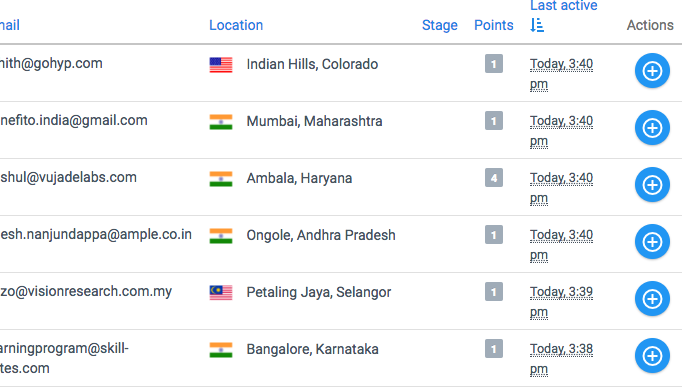
IV. Landing Pages
Another facet of automation that helps in nurturing leads is landing pages. A landing page acts as the entry point of a website or a particular part of your website. The page’s goal is to capture the visitor’s attention and convince them to stay and explore further.
If you want to generate a landing page that converts, you need to make sure that it is robust, there’s tracking, delivered with intelligence and smart design. You also need to think about trends in landing pages and what your competitors are doing.
Most automation tools come with drag and drop editors so that you can customize the elements of your landing page.
IMPACT, a branding and design company, has always been an inspiration for designs. The landing page they build is simple, prominent, and soothing to your eyes. They have a detailed highlight image, proper color coordination, all the elements to trigger further actions like subscribe to their blog.
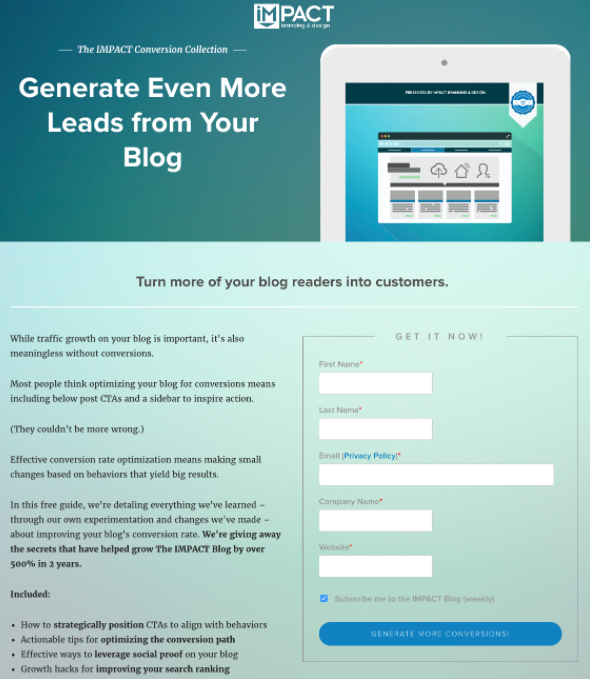
Landing pages are designed to urge your visitors to take the plunge while on your website. The first key to a good landing page is to keep the form short. If you are asking too many questions, your leads will bounce away. You cannot afford that. So, resort to progressive profiling where you ask the minimum questions like name, email address, location. The remaining information you gather over time. Many time, progressive profiling concept is associated with that of a date! To know more details, you can read this article from SmartBug- what is progressive profiling and how does it work.
V. Marketing Workflow Automation Templates
To nurture your leads properly, you need to create a proper workflow to effectively nurture your leads. Like, you need to automate the entire flow of your emails, tags, segments, landing pages – which one will go when and how. This is a element that is not just helpful but also saves a lot of time. At Aritic PinPoint, we provide automated email workflows feature so that you can concentrate on more critical matters. For instance, below is a product feedback automation sequence available on Aritic Pinpoint. You can customize or simply use this as it is.
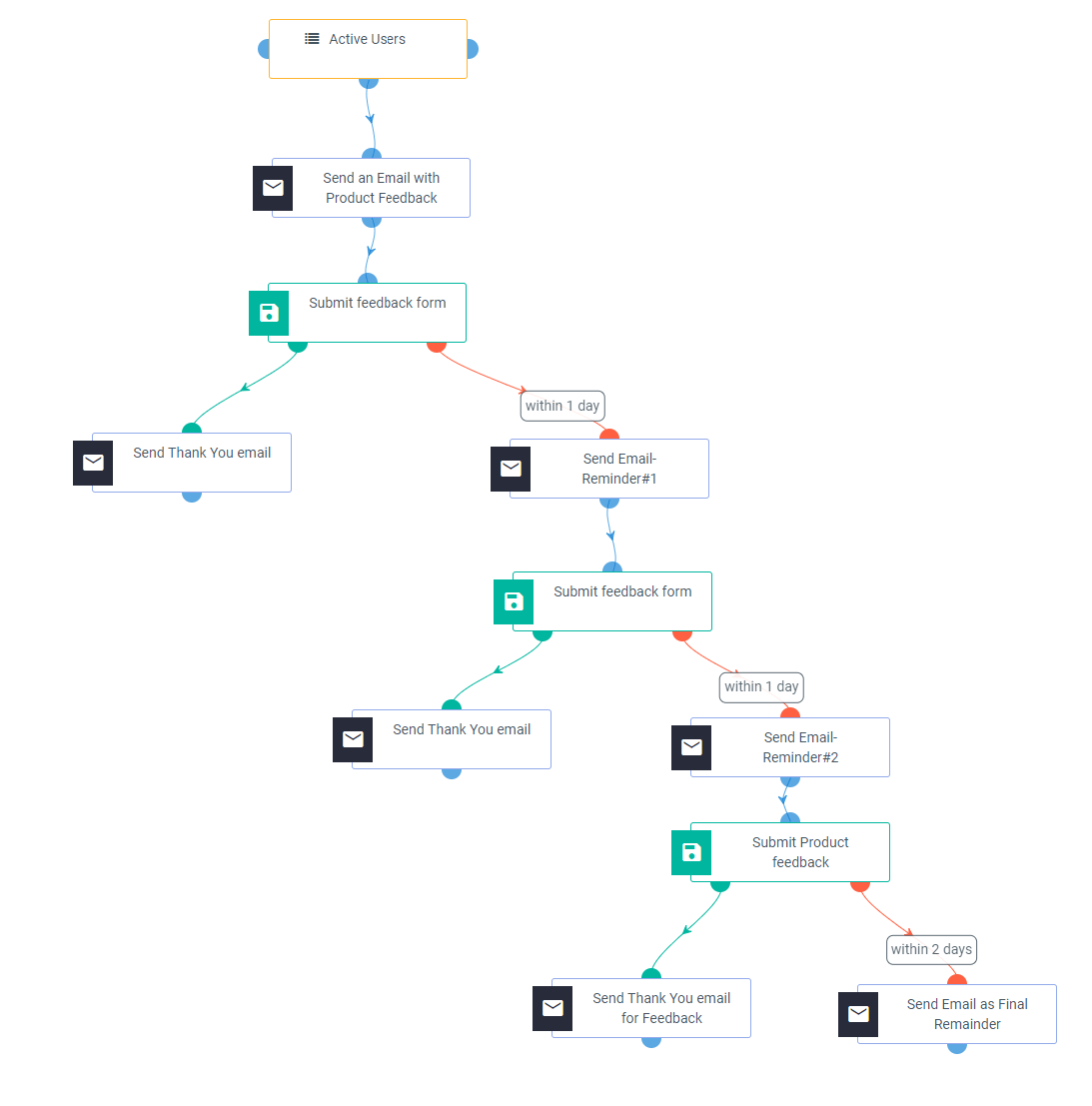
VI. Push notifications and SMS campaigns
Push notifications and SMS campaigns are two other ways of nurturing leads. Push notifications are quick notifications that appear either at the top of the screen or below (or wherever you want to) without hampering the browsing activity of your leads. You can send push notifications that are targeted and relevant using the Dynamic content. Dynamic content is a content type that keeps changing based on the browsing history, demographics, etc. of the leads. For instance, this push notification from MakeMyTrip – a travel itinerary portal.

SMS campaigns, on the other hand, are a great way to nurture leads via mobile devices. When you receive an SMS on an offer from a brand, that triggers some kind of interest in you (especially if you are a frequent buyer from that brand). Staying connected to leads irrespective of devices is essential to improve lead nurturing. For example, this SMS from Uber reminding me of a discount code that I haven’t yet used.
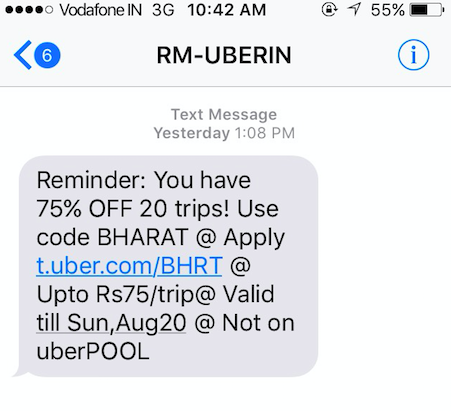
Messages and notifications like these urge a lead to check out more details and probably make a booking/purchase.
VIII. Content Marketing for Lead Nurturing
Content is the core of any and every marketing team effort. As digital marketing evolves and more businesses get online, the lead nurturing process becomes more important for marketers. Lead nurturing is a strategic process that aims at converting prospects into qualified leads by engaging them through different phases of the buyer’s journey. These days, marketing team is taking different strategies to increase their conversion rates and one of them is development of content marketing plan.
Content marketing for lead nurturing includes creating consistent and relevant content with a strong focus on the customer journey event. It needs to be well-targeted and should turn as carefully planned for maximum impact on prospects’ decision-making process one way or the other.
We need to create compelling content that will catch our customers’ attention and at the same time provide them with valuable information about our company/product/service that they are interested in. You can share a digital business card with potential customers that contains your contact details and links to the content you have created.
Whether you want to educate your audience or tell them about your product/services or launch an offer/contest- Content is the backbone. With excellent design and bad content, you can never get results. Like I mentioned earlier in this post, every lead goes through three stages before hitting the ‘buy’ button. And the content matter for each of these stages is different.
Awareness Stage
In the Awareness stage, leads are new to your platform. They are not yet sure if they really need your product/services. They haven’t yet subscribed to your blog or for your newsletters. After spending some time on your website and reading your content, they subscribe. But they are still not ready to buy or doesn’t show characteristics of interest. That’s why you need to excel at lead nurturing to create strong presence. What follows next is educational content- relevant content that will help these leads know more about the industry, the benefits, the various problem statements and their solutions, various resources, and likes of the same. Some content examples are:
- Analyst reports
- Research reports
- eBooks
- Editorial content
- Expert content
- Whitepapers
- Educational content
Consideration Stage
The next stage is Consideration. In this stage, your leads have moved one step ahead. They are now aware of the problems. Simultaneously, they are also aware that there are many solutions available. At this stage, they are considering feasible solutions that will suit them. For instance, you can send:
- Expert guidelines
- Live interactions
- Webcasts
- Podcasts
- Video
- Whitepapers on Comparisons
Decision Stage
Now your leads are aware of their issue, have skimmed through all the possible solutions, and have finally decided on the solution strategy. To propel them towards the buy button, you can create contents like:
- Vendor comparison
- Product Comparison
- Case studies
- Trial Downloads
- Product feature showcase
- Live demo
All these together, when sent in the right time to the right audience, will successfully create a conversion for your business. It apparently looks like an easy task, but creating good content to nurture leads is no cake walk! And to say the least, it is not just about creating a content piece. After the creation comes distribution. If you are not distributing your content effectively, you are again missing out your leads’ attention.
IX. Analytics and Reports
Without analytics and detailed reports, nurturing leads effectively is not possible. Unless you are measuring your marketing efforts, how will you know what will help in improving lead nurturing? Detailed analytics, region-wise reports, time-span reports, live updates- all these features in an automation tools helps in deciphering the outcome of all your practices.

If you see good results, you can continue, if not you will need to test more variants of each effort. We call it A/B testing– where you test your content, design, templates, CTA button placements, time, dates, etc. For instance, Aritic PinPoint offers region-wise/country-wise reports that are visually enriched and is much more detailed.
All these efforts when put together means a lot as it helps in improving your lead nurturing performance. Marketing automation tools provides all these latest features to let you create processes and tactic that attract and propel new leads into the marketing funnel and push them to the end where they convert. However, as I mentioned, lead nurturing doesn’t end even after the purchase stage. Rather, if you ask me, that’s where the main part begins. Holding on to your loyal users and keeping them satisfied is a challenge that needs a lot of attention.
TIP: To effectively nurture your leads, your sales and marketing team has to align with each other. They need to work together. Ideally, a marketing team passes on a quality lead to the sales teams who then convert them into paid users. But the ideal world doesn’t exist. Hence, both these teams have to already be constantly in touch to nurture a lead properly. Improving lead nurturing with automation requires you to tap and choose into multi-channel marketing to connect with your leads. The most effective channels (and widely used too!) are:
- Emails
- Social media platforms
- SMS Campaigns
- Push Notifications
- Landing Pages
- Mobile notification
Implement best lead nurturing practices with Aritic PinPoint! Start your Free trial.
⭐ What is Lead Nurturing?
Lead nurturing is the automated method of sending relevant and personalized content to the potential prospects for building a personal relationship with them.
⭐ Why do you need Lead Nurturing?
Lead nurturing efforts help in contact segmentation, email marketing, assigning lead scores to qualify leads, marketing workflow automation templates, and push notifications.
⭐ How to build a lead nurturing plan?
Take some time to review marketing automation tools to choose the best one, and it often includes several emails and interactions to bring the lead down the marketing funnel.
⭐ What is a lead nurturing campaign?
Lead nurturing campaigns are a series of marketing activities that are used to increase the likelihood of a prospect becoming a customer. Moreover, the lead nurturing campaigns assists the leads in the buying process based on their behavioral pattern and delivers them relevant information for guidance. Lead nurturing campaigns are often delivered through email and online messaging, but can also include direct mail.
⭐ What is lead nurturing strategy?
Lead nurturing is the process of converting prospects into leads and then eventually, nurturing leads into customers. It typically starts with an introductory email, which then graduates to a drip campaign that eventually turns into a conversion stage. In addition, it incorporates a procedure of providing relevant and create impact-laden information for building relationships with your customers at different stages of their journey.
⭐ How would you nurture an existing customer?
Customer loyalty is hard to come by, but it’s even more difficult to maintain. But at the end of the day, building customer retention strategies are all about making customers feel special. The best way to identify what your clientele likes? Asking them! Survey your clients on what they like most about your business, and how you can improve their experience with you.
⭐ How do you balance nurturing current clients with developing new business?
There are many strategies for balancing these two sides of the business. One strategy is to consider what you know about your current clients’ needs and goals so you can continue marketing to them while still looking towards future opportunities.
Knowledge of your client’s unique goals will help you decide how best to allocate resources and time between developing new business and keeping existing relationships strong.
⭐ Why is lead stage important?
As a sales rep, you will be more successful if you can identify what lead stage your prospect is in. How you handle each lead stage will depend on several factors that include:
#1 The level of interest your prospect has for your product or service
#2 Their likely needs and wants




13 Comments
This post certainly gave an in-depth look at how to best leverage marketing automation for lead nurturing. Undoubtedly a marketing automation software has it all. From scoring and grading to help in identifying the warmest leads, to automated alerts that lets our sales team know when to follow up! The results only depend on how effectively we use the tool and how appropriate it is for our requirements.
Usually the biggest sales come from building strong relations slowly over time and automated lead nurturing campaigns helps to save time and resources. Thus the sales team can focus more on the sales qualified leads.
Yes, by using a Marketing Automation software for lead nurturing campaigns will give us the power to build mutually favorable relations with high-quality customers.
Lead nurturing is very important for any marketer in B2B business to help in educating the lead and take them in a right path throughout their journey. They must be given all the special treatment they deserve.
Lead nurturing is far more important than producing new leads altogether. As already existing customers are more likely to stay than convincing someone foreign. This also helps divert more attention to the needs of the leads.
Lead nurturing is the most important marketing strategy as it helps us to convert our inbound traffic into real sales. In other words, we can conclude that it is beneficial to prove potential customers through the sales process. Good post.
Thanks for sharing such an informative article. I agree with all the useful tips discussed here and honestly believe that lead nurturing is the most critical marketing strategy as it helps us to convert our inbound traffic into real sales.
Thanks a lot for updating the effective ways to improve lead nurturing with automation, as these steps will give us the power to develop favourable mutual relations with high-quality customers.
If the lead nurturing is implemented with the help of marketing automation, you can build relations with high-quality customers.
Since the lead nurturing is essential for nurturing the existing customers, it can be helpful to gain more attention from the leads.
Very well written! Yes, you are right that lead nurturing is a great way to educate and entice the prospects. Keep it up.
Marketing automation software is hugely useful to drive high -quality customers! Great article!
In business, the only constant changes. The days of being an “efficient” person are gone. In this future-focused business climate, relationships with your clients and leads are becoming more serious and becoming the key to growth. Want to get ahead? Then you need to prioritize lead nurturing.